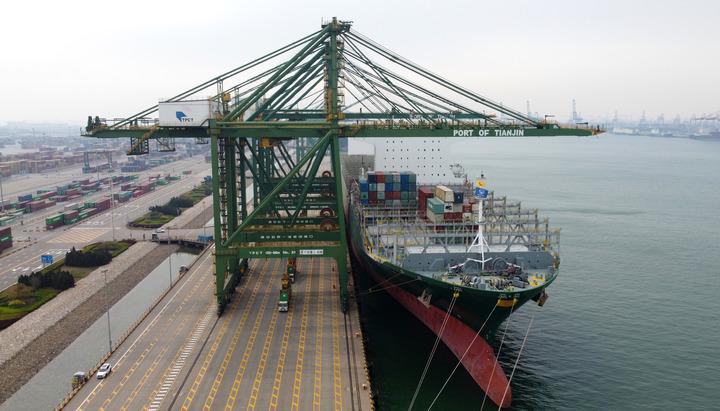In the first two months of 2021, China's import and export continued to maintain positive momentum, exhibiting the following characteristics:
There was a positive growth with China's major trading partners and a continuous optimization of the international market landscape. China's import and export with its major trading partners and other Belt and Road countries maintained growth. In the first two months, China's imports and exports with the top four trading partners, ASEAN, EU, the United States and Japan were 786.2 billion yuan, 779.04 billion yuan, 716.37 billion yuan and 349.23 billion yuan, accounting for 14.4%, 14.3%, 13.2% and 349.23 billion yuan of the total imports and exports during the same period, and they accounted for 48.3% of China's total imports and exports. China's imports and exports with ASEAN, EU, and the United States increased by 32.9%, 39.8%, and 69.6% respectively, 0.7, 7.6, and 37.4 percentage points higher than the overall import and export growth rate of the period. China's imports and exports with other Belt and Road countries totaled 1.62 trillion yuan, an increase of 23.9%.
The proportion of foreign trade in central and western regions of China increased, making the domestic regional distribution more balanced. Central and western regions of China are continuing to be opened up to the world, and their ability to undertake industrial transfer from the eastern region has increased, making the regional distribution of foreign trade more balanced. In the first two months, the foreign trade import and export of the central and western regions reached 975.11 billion yuan, an increase of 55.8%, 23.6 percentage points higher than the overall growth rate, accounting for 17.9% of the total import and export, an increase of 2.7 percentage points than the same period of last year. The potential of foreign trade in central and western regions is increasingly prominent, providing a precise boost to consolidating the achievements in poverty alleviation and comprehensively promoting rural revitalization.
Exports of both electromechanical products and labor-intensive products have grown. In the first two months, China's exports of electromechanical products totaled 1.85 trillion yuan, an increase of 54.1%, 4 percentage points higher than the overall export growth rate, accounting for 60.3% of the total exports. The exports of seven types of labor-intensive products including garments were 57.178 billion yuan, an increase of 49.2%, accounting for 18.7% of the total export. It reflects that the acceleration of China's industrial transformation and upgrading, the structure of export commodities are being optimized continuously, the stable quantity and increasing quality of foreign trade is being promoted.
The increasing trend of the import of key products is obvious, and the structure of imported products is more optimized. In the first two months, the imports of advanced technology equipment and key components grew fast, with imports of integrated circuits increasing by 25.9%, and imports of automobiles (including chassis) increasing by 16.7%.
Both prices and quantities of imported iron ores increased. For raw oil, natural gas, and other commodities, the imported quantity increased but their prices dropped.
1.82 billion tons of iron ores were imported, an increase of 2.8%, with average import prices increasing by 46.7%. 89,568 thousand tons of crude oil were imported, an increase of 4.1%, with average import prices falling by 27.5%. 20,796 thousand tons of natural gas were imported, an increase of 17.4%, with average import prices falling by 17.1%. The domestic economy continued the steady recovery, driving the imports to continue picking up.
Private enterprises play a prominent leading role, and the endogenous dynamic of foreign trade is increasing. The leading role of private enterprises in driving foreign trade is more prominent, and their positions as the top business entities are continuously being consolidated. In the first two months, the import and export of China's private enterprises totaled 2.57 trillion yuan, an increase of 49.5%, substantially higher than 16.3%, the overall growth rate of import and export, accounting for 47.2% of the total import and export, and 5.5 percentage points higher than the same period of last year.
The proportion of general trade has increased, and the methods of trade are continuously being optimized.
In the first two months, China's import and export under general trade reached 3.35 trillion yuan, an increase of 34.4%, accounting for 61.6% of the total import and export, while import and export under processing trade totaled 1.23 trillion yuan, an increase of 29.5%, highlighting that China's foreign trade structure is becoming more optimized, and the endogenous dynamic of development is increasing. In 2021, challenges and opportunities coexist for China’s foreign trade development, with many uncertainties and a severe and complicated import and export situation. The Ministry of Commerce will keep a foothold of the new development stage, serve the construction of the new development patterns, focus on the implementation of the quality imports and exports plan, trade and industry integration plan, and the unimpeded trade plan, resolutely stabilize the foreign trade and foreign capital fundamentals, promote the innovative development of foreign trade, play the better roles of foreign trade, as a key hub and main channel, in connecting the domestic and international circulations, and clearing and opening the global economic cycle, and fully achieve the goal of stabilizing quantity and increasing quality of exports and imports as proposed by the Report on the Work of the Government.
Written by:
Liu Jianying, Ph.D., Associate Researcher, Deputy Director of Department of Foreign Trade, Chinese Academy of International Trade and Economic Cooperation.




 A single purchase
A single purchase









